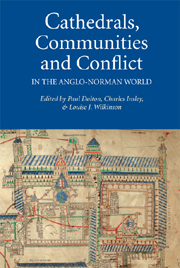Book contents
- Frontmatter
- Contents
- List of Illustrations
- List of Contributors
- Preface
- List of Abbreviations
- Introduction
- 1 The Dangers of Invention: The Sack of Canterbury, 1011, and the ‘theft’ of Dunstan's Relics
- 2 Remembering Communities Past: Exeter Cathedral in the Eleventh Century
- 3 Communities, Conflict and Episcopal Policy in the Diocese of Lichfield, 1050–1150
- 4 The Acta archiepiscoporum Rotomagensium and Urban Ecclesiastical Rivalry in Eleventh-Century Rouen
- 5 Cathedrals and the Cult of Saints in Eleventh-and twelfth-Century Wales
- 6 A Bishop and His Conflicts: Philip of Bayeux (1142–63)
- 7 Ecclesiastical Responses to War in king Stephen's Reign: The Communities of Selby Abbey, Pontefract Priory and York Cathedral
- 8 Secular Cathedrals and the Anglo-Norman Aristocracy
- 9 The Lives of Thomas Becket and the Church of Canterbury
- 10 Caught in the Cross-Fire: Patronage and Institutional Politics in Late twelfth-Century Canterbury
- 11 Crown, Cathedral and Conflict: King John and Canterbury
- 12 The English Monasteries and their French Possessions
- Index of People and Places
- Other Volumes in Studies in the History of Medieval Religion
5 - Cathedrals and the Cult of Saints in Eleventh-and twelfth-Century Wales
Published online by Cambridge University Press: 12 September 2012
- Frontmatter
- Contents
- List of Illustrations
- List of Contributors
- Preface
- List of Abbreviations
- Introduction
- 1 The Dangers of Invention: The Sack of Canterbury, 1011, and the ‘theft’ of Dunstan's Relics
- 2 Remembering Communities Past: Exeter Cathedral in the Eleventh Century
- 3 Communities, Conflict and Episcopal Policy in the Diocese of Lichfield, 1050–1150
- 4 The Acta archiepiscoporum Rotomagensium and Urban Ecclesiastical Rivalry in Eleventh-Century Rouen
- 5 Cathedrals and the Cult of Saints in Eleventh-and twelfth-Century Wales
- 6 A Bishop and His Conflicts: Philip of Bayeux (1142–63)
- 7 Ecclesiastical Responses to War in king Stephen's Reign: The Communities of Selby Abbey, Pontefract Priory and York Cathedral
- 8 Secular Cathedrals and the Anglo-Norman Aristocracy
- 9 The Lives of Thomas Becket and the Church of Canterbury
- 10 Caught in the Cross-Fire: Patronage and Institutional Politics in Late twelfth-Century Canterbury
- 11 Crown, Cathedral and Conflict: King John and Canterbury
- 12 The English Monasteries and their French Possessions
- Index of People and Places
- Other Volumes in Studies in the History of Medieval Religion
Summary
The cathedral churches of the four bishoprics of the Welsh, the reformed episcopal sees that emerged in the eleventh and twelfth centuries at Bangor, St Davids, Llandaf, and Llanelwy, had at their heart the cult of local founding bishops. All were rebuilt in the first half of the twelfth century; and for three of them – St Davids, Llandaf, and Llanelwy – posterity has handed down demon strations of major new activity around the cult of the patron saints. The shrines of the holy bishops honoured as founders, their secondary relics, and the formalised accounts of their lives – the accessories of the cult – were the focus for the objectives of the reforming bishops of the twelfth century; and each of these aspects of the cult was managed with judicious consideration.
St Davids
The best continuously documented of the cathedral churches of Wales is at Mynyw (Latinised as Meneuia), the place associated with St david (dewi Sant). Mynyw was subject to a series of devastating attacks during the tenth and eleventh centuries, from vikings as well as Mercians. On the cusp of the millennium, in 999, Danish pirates killed the bishop, Morgeneu: judgement for having been the first bishop since Dewi himself to eat meat. Eight decades later, in 1080, another bishop of Mynyw, named Abraham, was killed by vikings; this bishop's death demanded the calling back from retirement of his predecessor, the renowned and learned Bishop Sulien, who in 1078 had withdrawn to his old home in Ceredigion, the clas-church of Llanbadarn fawr, after five years as bishop of Mynyw.
- Type
- Chapter
- Information
- Publisher: Boydell & BrewerPrint publication year: 2011



